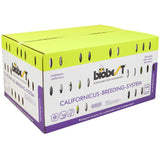Californicus-Breeding-System
Control of spider mites both in- and outdoors
What is Californicus-Breeding-System?- The predatory mite Amblyseius californicus against several types of spider mites
- Efficient against all stages of the greenhouse spider mite Tetranychus urticae
- Also useful to control tarsonemid mites such as the broad mite and the cyclamen mite
- Delivered in breeding sachets
- Prefers the greenhouse spider mites but also survive on other mites, thrips and pollen
- Most effective at low prey density
- Less sensitive to hot and dry weather conditions
- Also tolerates colder weather conditions
- Also survives on pollen or even without prey for some time
- They eat on average 5 prey a day
- Adults prefer larvae and nymphs of the greenhouse spider mites
- The larvae mainly eat the eggs of greenhouse spider mites
- Vegetable crops such as cucumber and pepper
- Soft fruit such as raspberry and strawberry
- Ornamental crops such as rose and chrysanthemum
Units
This predatory mite is also supplied in sachets, in which they multiply themselves. This ensures a continuous walking out of the predatory mite over multiple weeks.Californicus-Breeding-System-100
Packaging: 100 sachets/box
Contents: at least 100 predatory mites/sachet
Carrier: bran with bactitious prey
Walking out: approx 1.000 predatory mites in a period of 6 weeks
Californicus-Breeding-System-500
Packaging: 500 sachets/box
Contents: at least 100 predatory mites/sachet
Carrier: bran with bactitious prey
Relevant crops
- Medicinal cannabis
- Cucumber and Gherkin
Relevant pests and diseases
Spider mitesFiles
Downloads
Technical Sheet"












